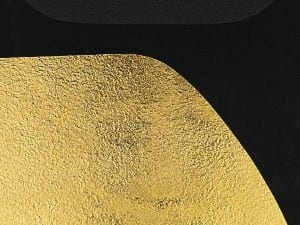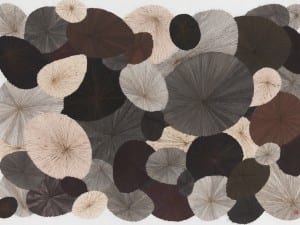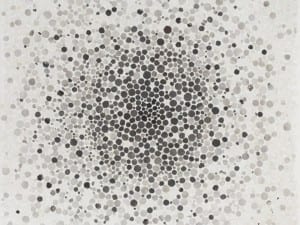Word by Word, curated by Francesco Bonami, which recently showed at Luxembourg & Dayan, explores the use of text by 20th century artists. The viewer is sucked into the depths of social, political and artistic commentary. Artistic meaning and context become the audience’s guidelines as Bonami lures us ever deeper through a brief but thoroughly calculated snapshot of text as art.
Language or, more specifically, words, have been utilised by artists in outstanding and innovative ways to bring new dynamics to their aesthetics. None more so than Joseph Kosuth. His installation One and Three Lamps (1965) problematises relations between the physical object, its visual representation and the verbal reference of said object. The meanings of the three elements are congruent in certain semantic fields and incongruent in others: a semantic congruity (“One”) and a threefold incongruity (“One and Three”). It is with a hint of irony that One and Three Lamps can be perceived as a model of the science of signs. The work challenges the viewer to question which is the real lamp to which the answer would be the definition, as without a definition, the viewer would never know what a physical chair is.
In contrast, Christopher Wool’s series of three works, My House I, My House II, My House III (2000), uses the slogan “IF YOU DON’T LIKE IT YOU CAN GET THE FUCK OUT OF MY HOUSE” beneath a distorted CMYK blotchy veneer. Each composition becomes foggier and more illegible than the last. The statement is comical yet at the same time brash and obtrusive. The fact that it is repeated and displayed in a familiar domestic-like fashion draws the viewer to censorship, and to consider where the line lies between a joke and something more offensive. Likewise, at the opposite side of the room, Rirkrit Tiravanija’s Untitled (same but not equal) (2014) also uses language combined with symbolism to confront social issues. A large board is covered in newspaper. On top of this, on the left hand side of the composition, is written in thick, black letters “SAME BUT NOT EQUAL”. The board is then balanced on two piles of rice, one jasmine and the other normal. Thus the differing monetary values accredited to the equal piles of rice become a visual metaphor for social standings and judgements.
On Kawara’s May 19, 1991 (1991) offers the most exuberant use of text. Having just had a remarkable retrospective at the Guggenheim in New York, Kawara’s signature date painting laments a life of art, and one of rigorous ritualistic formalities. Kawara began producing these paintings in 1966, using a monochrome background on which he wrote the date the painting was executed, in the language and according to the calendar of the country that Kawara was in at the time. If he did not complete a painting by midnight, he destroyed it. Some days he made two paintings; very occasionally, he made three; but most days there were none. Every painting in the series conforms to one of eight sizes, all horizontal in orientation, ranging from eight by ten inches to 61 by 89 inches. For every painting the artist mixes the paint at the time so that the colour of each is unique. Letters, numbers, and punctuation marks are then built up by hand. It is here that language and text is infused with necessity and legacy. Kawara’s self-imposed rules regarding his artistic operation, frequently resulting in failure, exposes a deep resilience and perseverance. It is the epitome of what Bonami calls “the silent cacophony of reverberating words.”
Word by Word showed at Luxembourg & Dayan, London, from 30 June – 5 September 2015.
William Davie
Follow us on Twitter @AestheticaMag for the latest news in contemporary art and culture.
Credits
1. Word By Word installation view, 2015. Courtesy of Luxembourg & Dayan.





